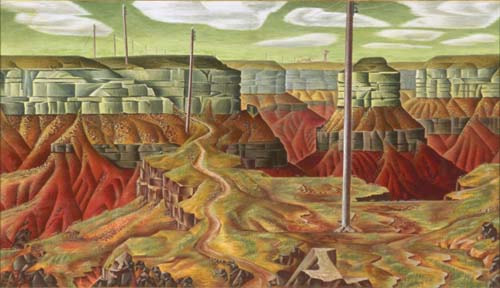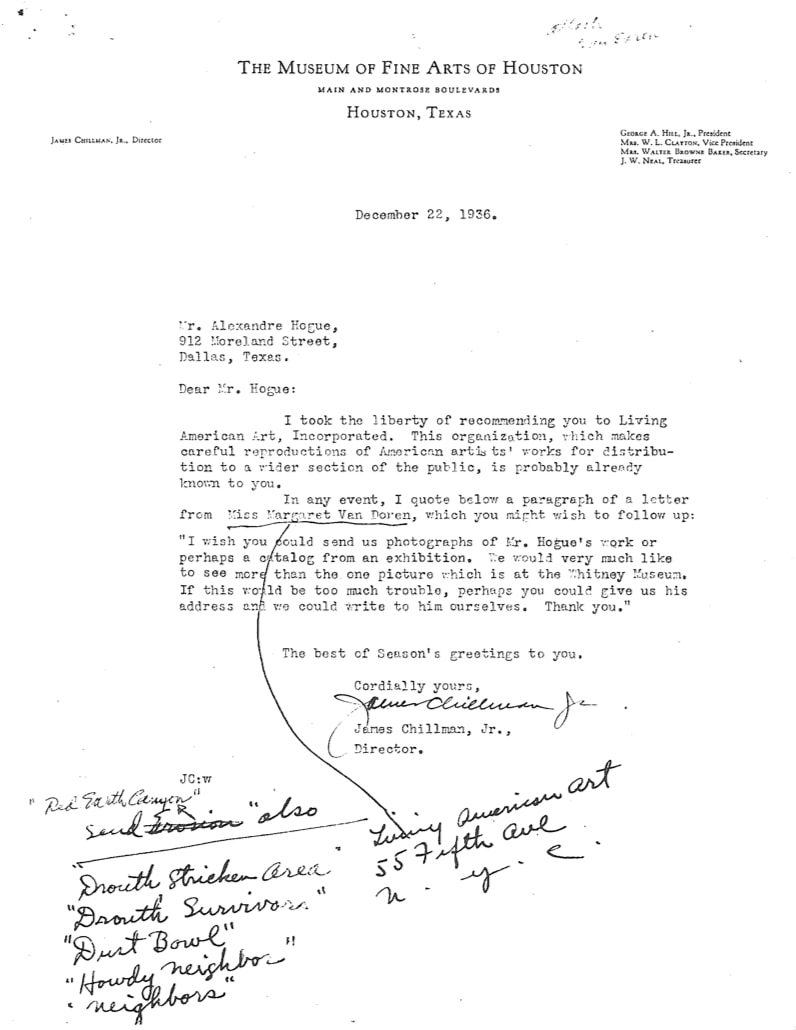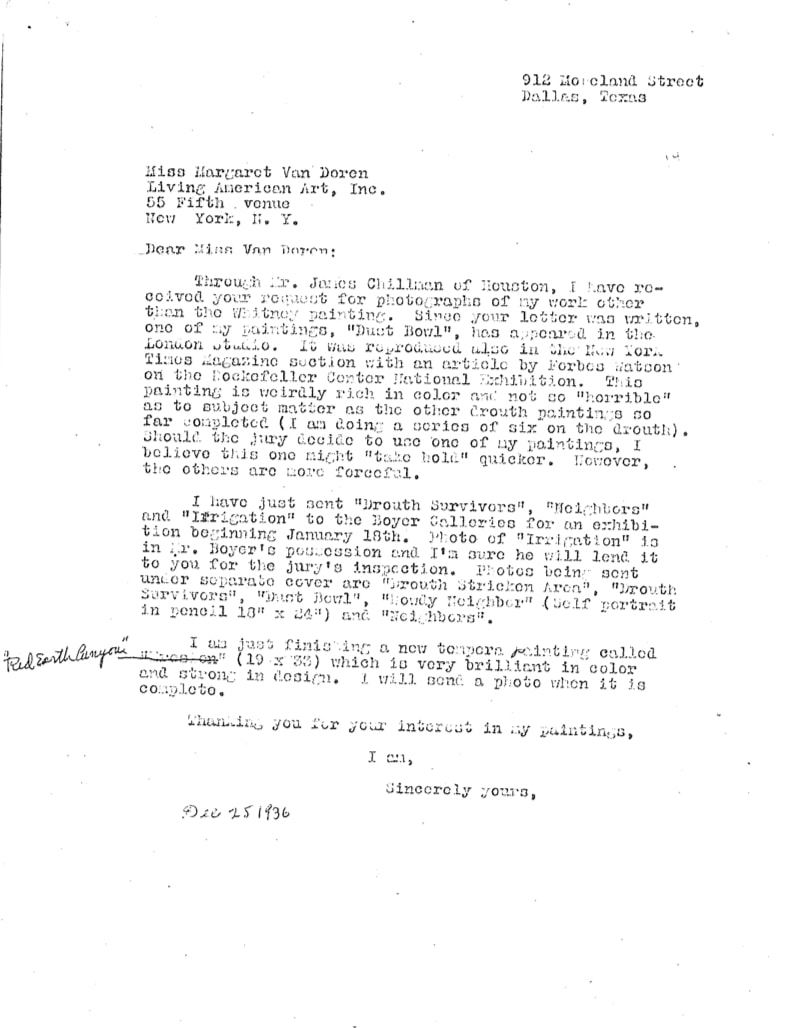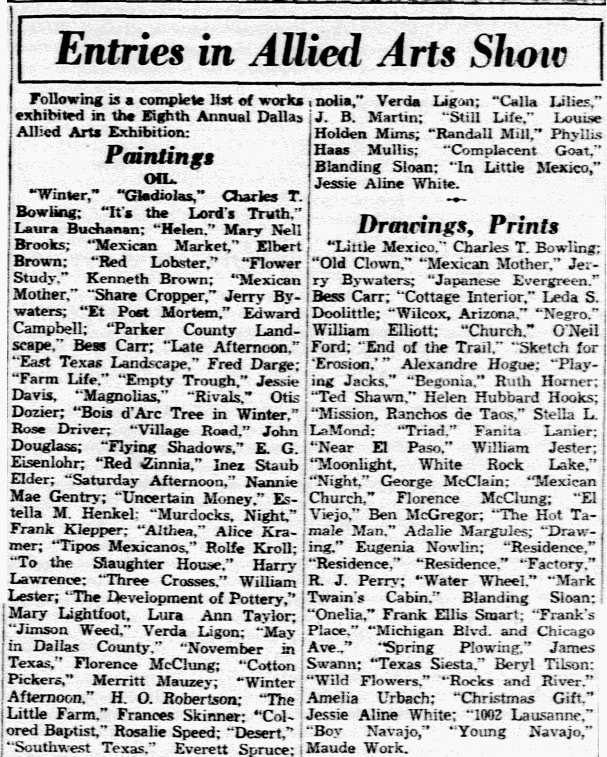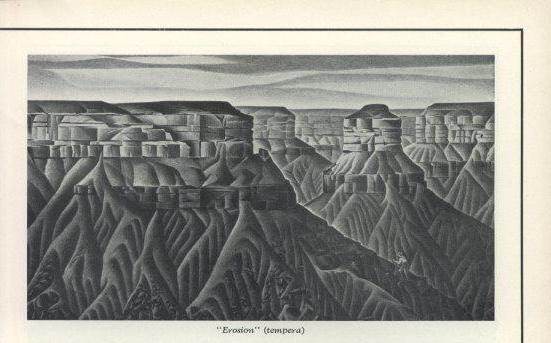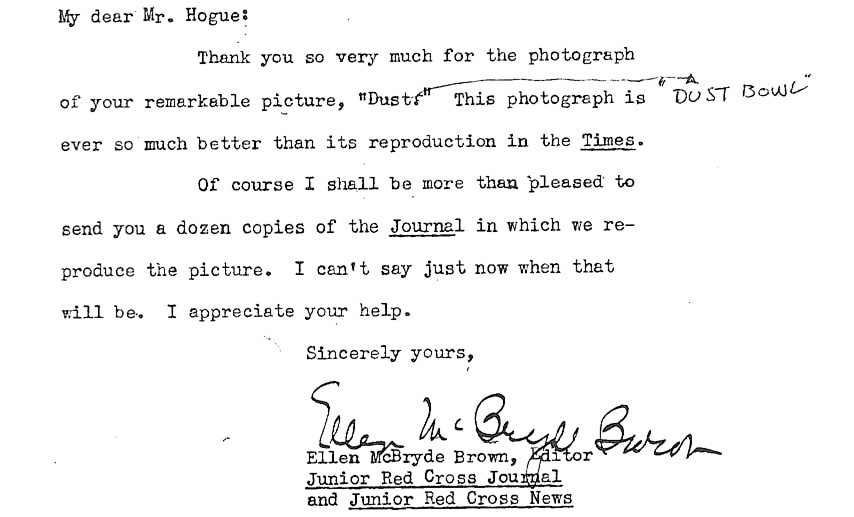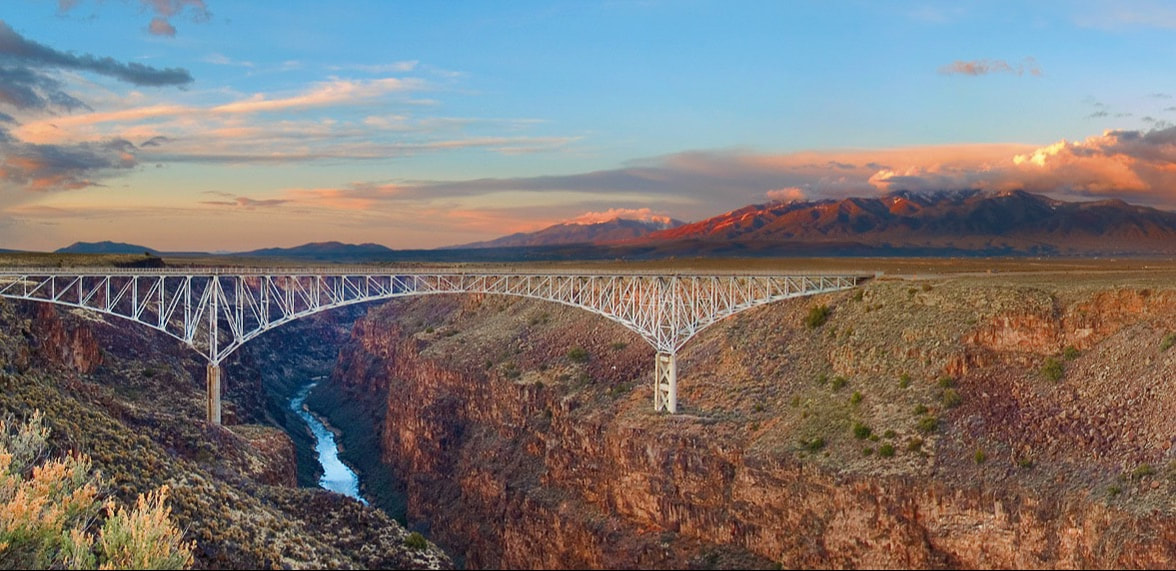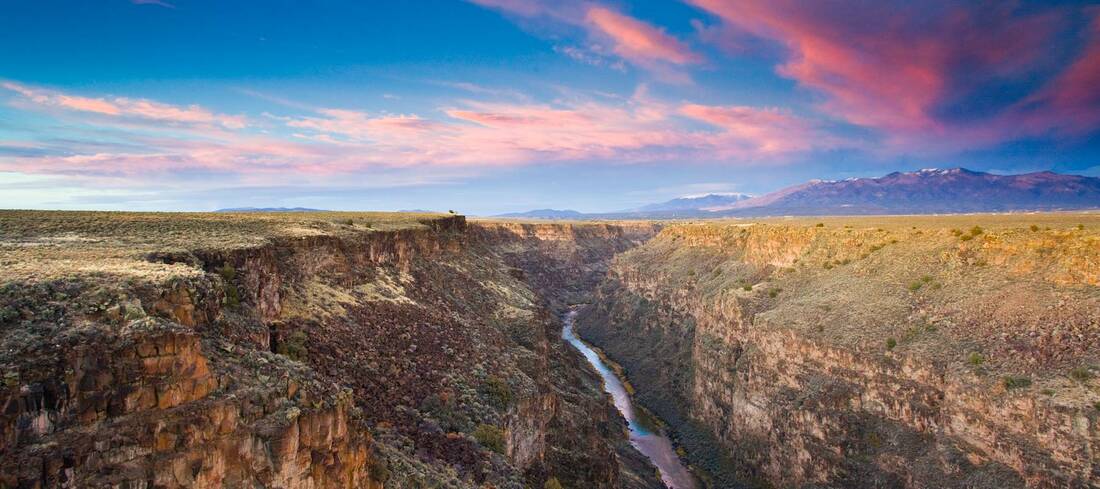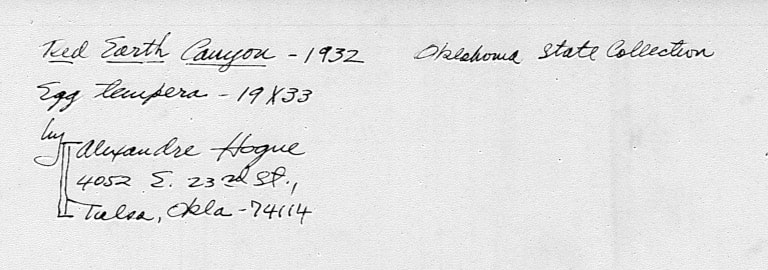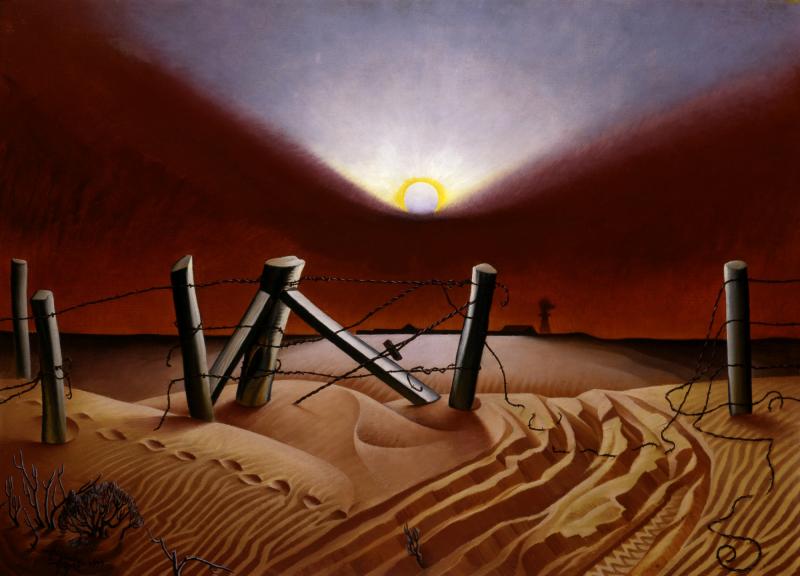|
Alexandre Hogue completed his painting Red Earth Canyon in 1937 (Figure 1). Red Earth Canyon was the first painting in his Erosion series to draw attention to the power and destructive force of water erosion. While this painting focuses on erosion by nature, Hogue’s later Erosion series paintings would focus on the erosion brought by human activity. Hogue’s paintings are harsh and confrontational towards those who have destroyed the environment through recklessness and inconsideration. His hope was for his paintings to spark conservation efforts and a desire for change among Americans. Figure 1. Alexandre Hogue, Red Earth Canyon, 1937, State of Oklahoma Art Collection. The book Alexandre Hogue: An American Visionary (Texas A&M University Press, 2011) claims Red Earth Canyon was created in 1932. However, according to letters in the Smithsonian Archives of American Art, Hogue completed Red Earth Canyon in 1937. On December 22, 1936, Hogue received a letter from James Chillman, the director of the Museum of Fine Arts of Houston, Texas (Figure 2). In the letter, Chillman quoted a request from Margaret Van Doren asking for photographs of Hogue’s work to be reproduced for Living American Art, an organization that distributed prints of artwork to the general public by mail. At the bottom of the letter, Hogue made a list of paintings to send Van Doren. At the top of that list, Hogue wrote “Send Erosion also” and then crossed out “Erosion” and wrote “Red Earth Canyon.” Prior to 1937, Red Earth Canyon was titled Erosion. Hogue most likely went back through the letters written prior to 1937 and corrected the title of the painting from Erosion to Red Earth Canyon. Figure 2. Alexandre Hogue, letter from James Chillman to Alexandre Hogue, December 22, 1936. Archives of American Art, Smithsonian Institution, Reel No. 1481. On December 25, 1936, Hogue replied directly to Van Doren (Figure 3). Hogue explained in his letter he was “just finishing” his painting titled Erosion (again Red Earth Canyon was later written in) and gave a description of its brilliant colors and design. Hogue goes on to say he will send a photograph of the painting when it is complete. Figure 3. Alexandre Hogue, letter from Alexandre Hogue to Margaret Van Doren, December 25, 1936. Archives of American Art, Smithsonian Institution, Reel No. 1481. These letters concerning Living American Art in 1936 are the first records of the painting being mentioned by anyone. Hogue was in the process of finishing the painting in late December 1936 and there is no proof of completion until 1937. On January 17, 1937, a drawing by Hogue titled Sketch for Erosion was listed in The Dallas Morning News as a part of the Dallas’ Eight Annual Allied Arts Exhibition (Figure 4). Sketch for Erosion would have been submitted in 1936 to be listed as a part of the exhibition in early January 1937. The sketch would have been created prior to Hogue’s painting as a way to plan out Hogue’s vision for Red Earth Canyon. Figure 4. “Entries in Allied Arts Show,” Dallas Morning News, January 17, 1937. A photograph of Hogue’s painting Erosion in the 1937 Soil Conservation Handbook was the first photograph of the original finished painting Red Earth Canyon (Figure 5). This is also further proof Hogue’s Erosion and Red Earth Canyon are the same painting. Hogue will later continue to add on to this painting and make changes until the image is complete. Figure 5. Alexandre Hogue, Erosion, 1937, Soil ConservationHandbook (Washington, DC: US Department of Agriculture, March 1937), 202. It is a possibility Hogue’s Red Earth Canyon was of the Rio Grande Gorge near Taos, New Mexico. Beginning in 1932, Hogue traveled with students from the Texas State College for Women to Taos during the summer semester to teach a field study class on painting. The summer before Red Earth Canyon was completed, a letter from Ellen McBryde Brown was address to Hogue in Taos on August 24, 1936 (Figure 6). Figure 6. Alexandre Hogue, letter from Ellen McBryde Brown to Alexandre Hogue, August 24, 1936. Archives of American Art, Smithsonian Institution, Reel No. 1481. In 1973, Hogue wrote to Van Deren Coke concerning his time in Taos, New Mexico. Hogue explained his studio was at the Kibbey Couse house, the home of the son of Taos artist E.I. Couse (Figure 7). Figure 7. Alexandre Hogue, letter from Alexandre Hogue to Van Deren Coke, April 25, 1973. Archives of American Art, Smithsonian Institution, Reel No. 1481. According to historians at the Couse-Sharp Historic Site in Taos, Kibbey Couse was living in the Couse home in the summers and Joseph Henry Sharp occupied his studio on the Couse site throughout the 1930’s (Figure 8). It is unlikely Hogue would have used the Couse site as his studio location since it was already in use by another artist. However, there is the possibility Hogue’s studio was located in an earlier Couse rental home off of Pueblo road. Figure 8. Email from The Couse-Sharp Historic Site to Russel Tether Fine Arts Associates, February 27, 2019. The Rio Grande Gorge is twelve miles from where Hogue was teaching and possibly living in Taos. The colors of the Rio Grande Gorge as well as the vertical lines are strikingly similar to Hogue’s painting (Figure 9). This gorge near Taos would have been the most convenient choice for Hogue to model his painting after, since his teaching schedule did not allow him the time to travel to other areas. Figure 9. Rio Grande Gorge. Digital Image courtesy Mona Makela Photography LLC. www.monamakela.com. Later on in his life, Hogue incorrectly claimed Red Earth Canyon was completed in 1932, even though his letters proved the painting was still incomplete in 1936. When donating his letters to the Smithsonian Archives of American Art in the 1979, Hogue included photographs of his paintings where he gave a brief description. Alongside the photograph of Red Earth Canyon, Hogue backdated this painting to 1932 (Figure 10). Figure 10. Alexandre Hogue, “Description of paintings,” 1979. Archives of American Art, Smithsonian Institution, Reel No. 1482. Hogue’s incorrect claim to the 1932 date in 1979 is most likely what led the painting to be dated 1932 in Alexandre Hogue: An American Visionary. However, after the discovery of documents concerning Red Earth Canyon in the Smithsonian Archives of American Art, the painting was still incomplete in December 1936 and there is no record of its completion until 1937. Russell Tether, President Katherine Hillman, Associate Russell Tether Fine Arts Associates, LLC
Comments are closed.
|

